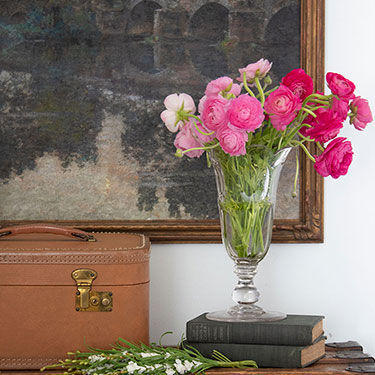How To Line A Cast Iron Planter With Moss
I recently found the most beautiful antique cast iron planter at the flea market. This was one of those finds where I couldn’t snatch it up fast enough when I saw it.
Once I got it home, I was left with the decision of what to plant in this beautiful planter to complement its age and patina. I didn’t want to take away from that.
While I was deciding on which plants to use for my small front porch this summer, I began working on lining the planter first.
The easy way to line a cast iron planter (or any open planter) is with coconut moss. However, I don’t love that look, so I decided to try live moss. What could compliment this 1920s planter better than moss?
I’ve used live moss in the past to make moss topiaries, which held up well so I decided to give that a try.

supplies needed to line a cast iron planter with live moss
- Sphagnum Moss
- Live Sheet Moss
- Potting Soil
- Coconut Fiber
- Bucket of Water
I had ordered one 3-5 lb box of the live sheet moss and it was just enough to do this large planter with a little left over. The leftover was used to fill one small metal planter on my porch.
how to line a planter with moss
The first thing I did was lay a sheet of coconut fiber on the bottom of my planter. This was to prevent the sphagnum and live moss from falling right through the bottom. I added a layer of sphagnum moss to cover it.

Live moss is more expensive than sphagnum so I only wanted to use the live moss along the outer edges where it would be visible.
When using the sphagnum moss, I soaked it first in a bucket of water to get it saturated. This helps it hold it’s shape better.

The live moss also needs to be wet to hold it’s shape. To moisten it, I lightly sprayed it with the hose.
Then I took pieces of the damp moss and pressed it along the inner walls of the planter. If the moss is dry, it will not stick at all. Even when damp, it didn’t always hold right away.

After each section of moss I placed, I would add potting soil behind it to help the moss stay in place. Wetting the potting soil to a mud-like consistency really helped everything stay where I wanted it.

This part is so messy but SO fun! I don’t know why my hand looks so clean in that picture, I was covered with mud. I had a gardener’s manicure after this one for sure.
prepping for plants
Working in sections with the moss and mud, it took a while to get this large planter filled. Once the sides were all lined with moss, I added more potting soil in the center to prepare for planting.

I absolutely love ferns of all varieties so I knew I’d be adding those to this planter. And because this would be on my shady porch, I had to use shade-loving plants.

The plants I chose for this planter are:
- Yellow Begonias
- Elephant Ferns
- Coleus (for height)
- Ivy (for spillers)
- White impatiens (filler)

Isn’t that pretty? I love how it turned out and I can’t wait to see how it looks in another month when the coleus has more height and the ivy trails over the sides!
maintaining a moss-lined planter
In order to maintain the moss and keep it in place, you cannot let it dry out too much.
My hose nozzle has a mist setting which is ideal for using on the moss. I will mist it from all sides every day or so when I’m watering the porch plants. When it’s extremely hot, I’ll do it every day.

This vintage planter is the star of my porch this year. It makes me happy every time I walk up to the door!



This is just beautiful. I live in an apartment and have a recessed north facing balcony so don’t even try to work with live plants. However, I have many planters filled with faux greenery and some floral stems. This is an inspiration for next summer. Thanks!
I’m so glad it inspired you, thanks!
It came out so pretty. Love it 🩵
Thanks 🙂
Very nice! Your porch is eye-catching!
Thank you 🙂